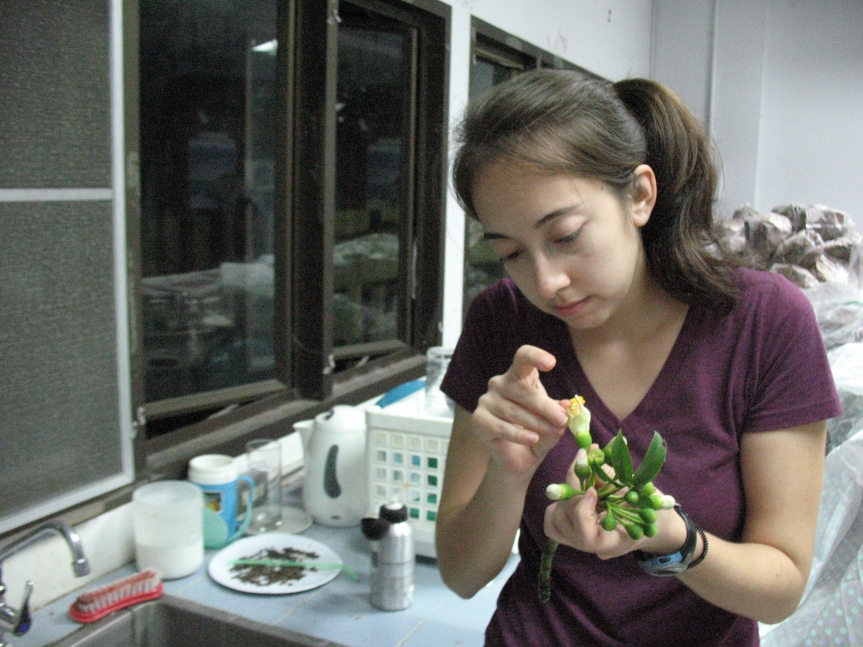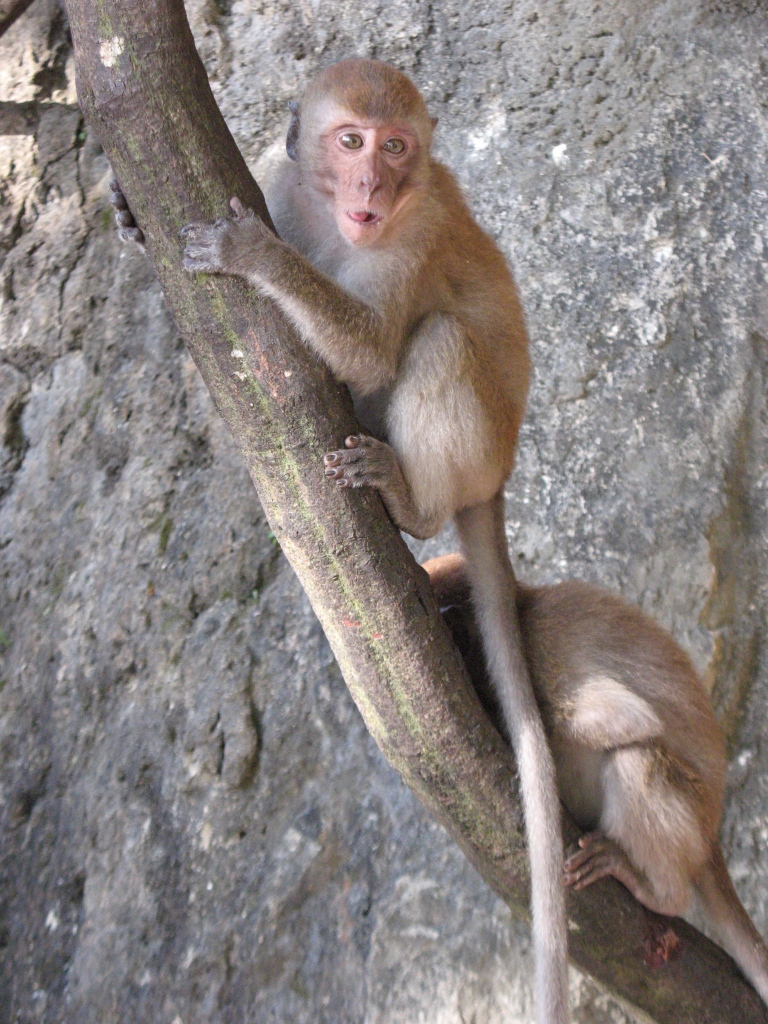My friend Alyssa Stewart studies bat pollination in Thailand. I visited her this December to help* her with one of her dissertation chapters and to do a small study of our own. Alyssa is studying just how good the flower-visiting bats are as pollinators in Thailand. The most common flower-visiting bats there are: Eonycteris spelaea (the dawn bat), two species of Macroglossus, two species of Cynopterus, and a small Roussettus.

From the plant’s perspective, the value of a bat depends on how often it visits the flowers, how much pollen it can carry, and how effectively it carries that pollen to another flower of the same species, rather than to a different species or to the bat’s stomach (I have always thought that pollen placed on a bat’s body should taste pretty bad to dissuade the bats from eating it, which is the first thing I wanted to study, but we shelved that idea).
So Alyssa has been studying these bats and their pollination of several flowers including the genera Parkia (seen below), Durio, Ceiba (silk cotton tree), Musa (banana), Oroxylum, and Sonneratia.
Merlin Tuttle has some great photos from Thailand of Eonycteris visiting flowers here. Including this gem:

I tried to take this same picture of Eonycteris visiting a Parkia flower and this is my version, which is just as good as you can see:
Over evolutionary time, flowers have switched from birds to bats more often than vice versa, because bats are often better pollinators due to their fur holding more pollen. Even though bats often drink more nectar, many plants are willing to pay that cost in exchange for the excellent pollination services of bats.

Most work on bat-flower mutualism has focused on neotropical bats and flowers. Alyssa’s work highlights many of the similarities and differences between the Old World and New World bat-flower mutualisms. For one, the paleotropical bats don’t have sophisticated echolocation like their neotropical cousins that are capable of hovering and feeding precisely from each flower like a hummingbird. Like in this video:
The paleotropical bats instead crash-land on the flowers, often getting the pollen on their face, body, and wings. Like these videos of Dawn bats feeding on banana flowers (warning the video has music but its nice music):
Actually, these flower-visiting bats do have a very primitive form of echolocation first discovered by Ed Gould and recently studied in much greater detail by Arjan Boonman, Yossi Yovel, and Sara Bumrungsri. The bats somehow click their wings to produce biosonar, which helps them avoid obstacles but it is not very precise or high resolution. This primitive echolocation helps the Dawn Bat navigate in the pitch black of the caves where it roosts. I actually tried getting some recordings of these clicks myself. They were quite difficult to record or differentiate from background noise, and they would really only make them under absolute darkness, just as described in the study. It is astonishing how great the night-vision of these fruit bats was. It’s described further in the supplement to the Boonman et al. paper. Anyway, back to the flowers…


Alyssa’s prediction was that each flower species would place its pollen on different parts of the bats’ bodies such that the bat would be better at delivering pollen to the same species rather than to different species. So her experiment was to catch a bat, fast it so that it would be hungry, and then release it in a room with a male flower. After the bat visited the male flower, she would unveil a female flower. Hopefully, the bat would visit both flowers so that she could count how many pollen grains were transferred. Usually, the bat just flew around the room freaked out, but if we were lucky, it visited both flowers within 30 minutes.

Alyssa tested different bats under several conditions: sometimes the bat would transfer pollen from a male to a female of the same species. Other times, it would transfer pollen between flowers of two different species. Her prediction was that pollen transfer within species would be greater than between species (making the bats very efficient pollinators). This seemed to be the case so far while I was there, and the difference was quite dramatic.
The other small study we did was to see whether Eonycteris was attracted to the scent of dimethyl disulfide (DMDS), an odorous compound found in many neotropical bat flowers (it smells terrible!).
A team from Germany found that DMDS is intensely and innately attractive to flower-visiting bats in the neotropics. When I worked with captive flower-visiting bats of the species Glossophaga soricina, I walked into a room with a tiny amount DMDS in a test tube and they all started hovering over to me and sticking their heads inside the tube. And these are bats that have never smelled odor this in their life.
DMDS acts as a powerful bat lure in the scent bouquets of many bat-pollinated flowers. And at first, it seemed like it was a general aspect of the bat pollination syndrome, along with pale petals that open at night. However, a later study found that DMDS was not found in many bat-pollinated flowers of West Africa. Most remarkable is the case of the silk-cotton tree (Ceiba pentandra), which is pollinated by bats on both the hemispheres. C. pentandra flowers possess a substantial amount of DMDS in Central America, but the later study found that the same species of flower contained no detectable DMDS in West Africa. In Thailand, we did not detect a strong sulphurous odor in C. pentandra. In fact, they smelled pretty nice. Finally, another study found that Cynopterus sphinx— a fruit bat that often feeds on flowers– was not attracted to DMDS.
To me, all this suggested that DMDS as a bat lure evolved only in the neotropics and is therefore probably unattractive to palaeotropical flower-visiting bats. So we tested the most common nectar bat in Thailand, Eonycteris spelaea, with choices of four Ceiba pentandra flowers, where one random flower was scented with DMDS. Rather than preferring the DMDS-treated flower, 21 of 22 bats chose an untreated flower. So they actually appeared to avoid it. In stark contrast, when I conducted the same test with the neotropical bat Glossophaga soricina, they were more than ten times more likely to visit the DMDS-treated flower first. This result suggested to me that the role of DMDS in bat pollination syndromes may be limited to the New World tropics.
At times, our trip was filled with great peril as when Alyssa almost beheaded herself in her desperate attempt to cut down flowers high in a tree by tenuously balancing heavy plant shears loosely attached to a long pole, attached to another long pole (what could go wrong). I was supposed to be helping that day but decided to stay behind in the air-conditioned lab with my computer working on my dissertation (that may have happened a few* times). The shears came down and luckily only nicked her lip between her nose and mouth requiring only a few stitches, but she then had to wear a bandage that made her look like she had a ridiculous Adolf Hitler moustache, and I had to try really hard not to laugh while talking to her about serious stuff (I could not even smirk). It is remarkable though how much a Hitler moustache changes someone’s appearance. I also had to suppress my urge to ask to take a funny photo for my blog. So really that was difficult for both of us.
We submitted our DMDS study, leaving out the minor detail that we conducted our behavioral tests in a laundry basket (“an experimental cage”). I look forward to Alyssa’s study on pollen transfer. When I left Thailand, she was heading north to Bangkok to find Durian flowers in bloom to finish off her study. A huge thanks to Alyssa for a great time and for showing us Thailand and it’s bats. We had a lot of fun.


The only big disappointment was not finding stalk-eyed flies for our lab. My confessional is that, on the last four days, when we could have been looking for flies around mosquito-infested streams, Michelle and I instead decided to visit the rock climber’s beach paradise of Railay, where huge overhanging limestone cliffs strewn with stalactites and bat caves come straight out of the seaside beaches. These were some of the best days of my life. The climbing was amazing.





Interesting post and I’d like to comment on a couple of things. When you hypothesise that pollen ought to be distasteful, there are many plant species which provide either pollen alone as a reward or pollen plus nectar. I’ve always imagined (and may even have read) that many bat pollinated plants are both pollen and nectar rewarders. Pollen is relatively cheap to produce for a plant, and many plants produce far more than could ever be expected to sire seeds.
With regard to your DMDS study, a lot will depend on the amount of the chemical you use and the context in which it’s applied. Many years ago we found that what we though were very small amounts of an organic volatile known to attract flies to flowers was actually repellent to them at the amounts we were adding to artificial flowers. It was only when a colleague used much, much smaller amounts that we found an attractive role. Also, for these bats, the context in which they encounter the DMDS is important. They need time to associate it with a reward. So it may not be that it’s repellent as such, rather that the bats have not figured out that this new smell means there’s nectar in the flower.
Look forward to seeing this work published.
LikeLike
Hi! Thanks for those comments. We submitted this to a free OA journal which I believe you and others started (Journal of Pollination Ecology). I think you guys are doing great things with that journal, especially pairing each article with a summary in Pollination magazine.
Yeah, the “yucky pollen” idea will be wrong if the pollen is cheap enough and not very endangered by the bat eating it. There’s certainly no evidence for it that I have seen. Plus if the pollen is strategically place, say, on a bat’s crown (out of reach), there’s no need for it to be yucky.
As for DMDS, the neotropical bats do not have to learn it. It’s innately attractive. Even captive-born neotropical flower bats that have never experienced DMDS love the smell. The wild flower bats love it even more. But the paleotropical bat was not interested in it at all.
The idea of sulfur-smelling flowers attracting bats is well known. But there’s actually no strong evidence that the DMDS part of the bat pollination syndrome is effective outside the neotropics.
LikeLike
Hi Gerry – Greetings from NE Thailand and thanks for this great article! We’ve long been trying to find someone to work with on bats out here where we’re based, but the search has been consistently fruitless. Is there any way you could link me up with Alyssa, so that I can pick up the discussion again…perhaps she can help link us up with the correct research institute and/or students that would like to work with us? Thanks again, Bryan @ Raitong Organics Farm
LikeLike
Here is her contact info: http://plantscience.sc.mahidol.ac.th/?page_id=679
LikeLike